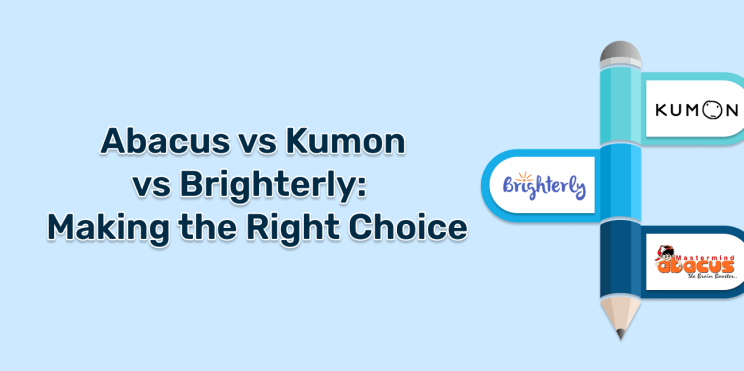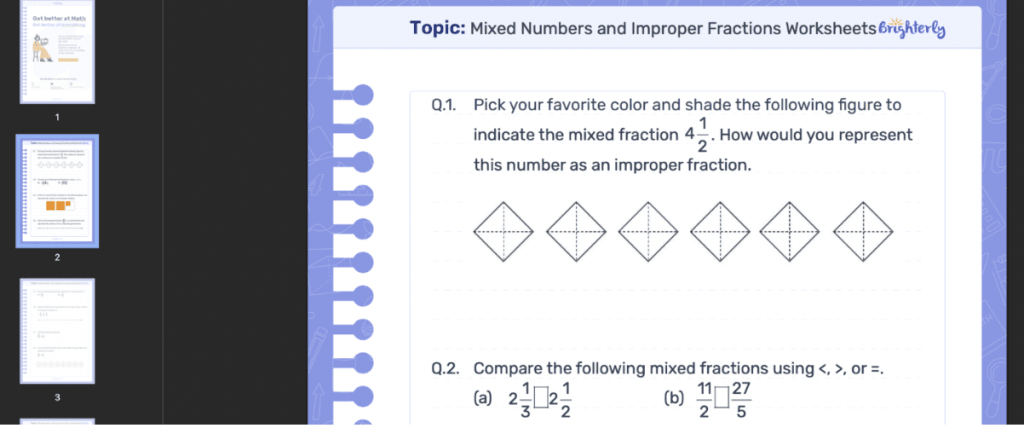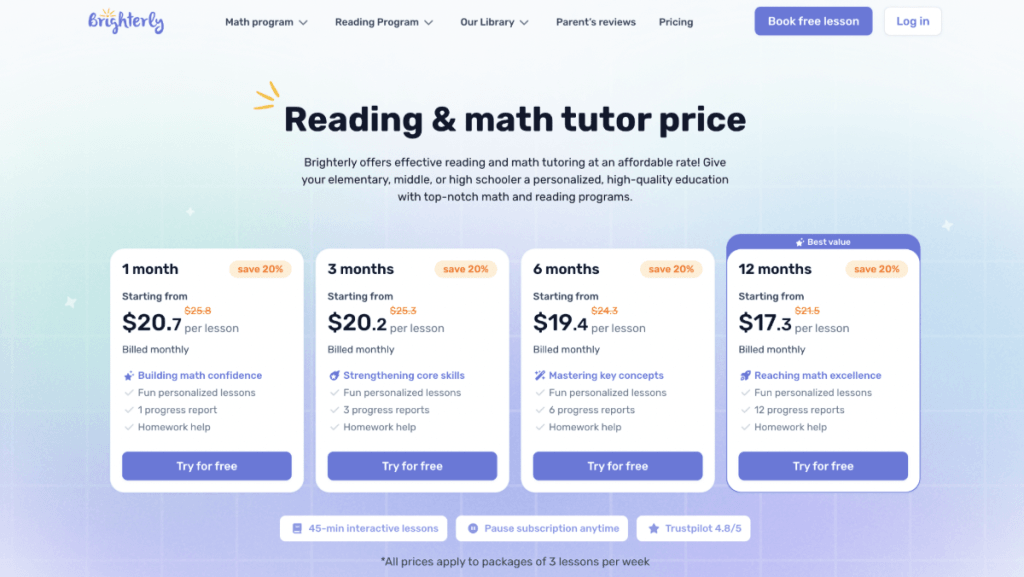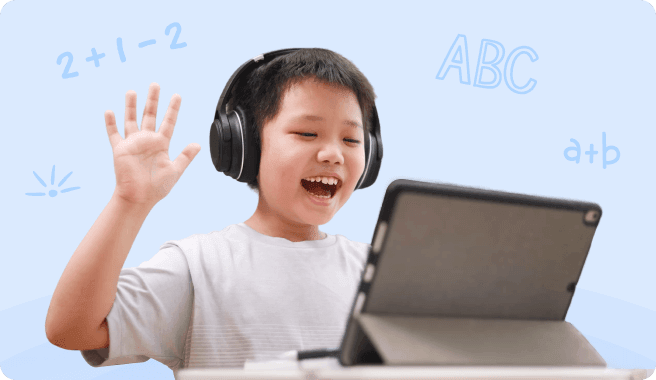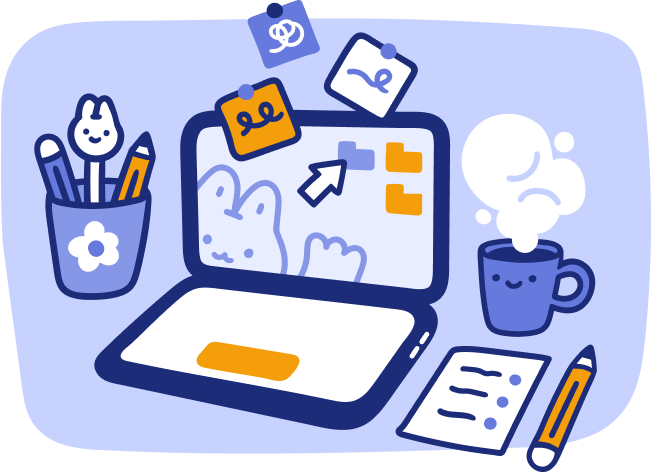Abacus vs Kumon vs Brighterly: Making the Right Choice
reviewed by Jessica Kaminski
Updated on October 30, 2025
Picking the right learning platform for your child can be difficult. And since you have so many options available to you, it’s important that you have the most up-to-date info on what each platform actually offers. I’m an expert tutor, and today I’m going to walk you through which platform is perfect for you — Abacus vs Kumon vs Brighterly.
Key points
- Which platform is a better choice depends on your child’s learning needs, goals, knowledge gaps, and learning style.
- Brighterly is an e-learning platform for 1st-9th grade students and offers engaging and adaptive learning plans for students.
- Kumon is a tutoring program for K-12 students in math and reading, focusing on a proprietary teaching method + small-step worksheets and drilling exercises.
- Abacus is a tutoring platform that focuses on hands-on learning through abacus for children in pre-school and elementary.
💡 So, if the question “Which is better Kumon or Abacus or Brighterly?” I’ll give my unbiased opinion on the platforms’ impact, features, teaching methods, user experience, pricing, and more.
Exploring alternatives?
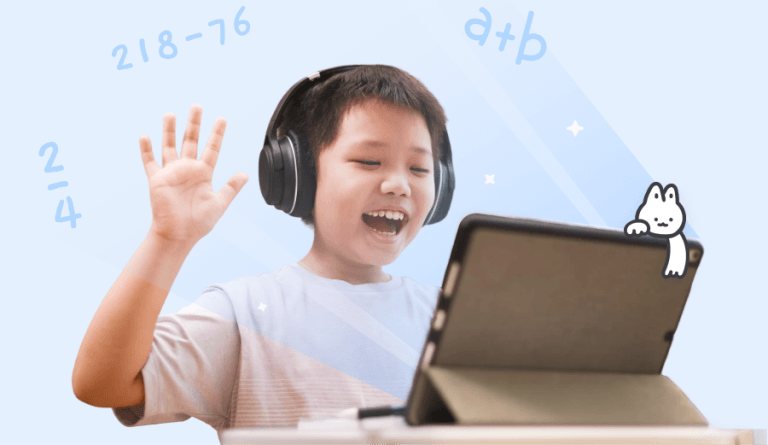
Abacus vs Kumon vs Brighterly: Comparison
The main difference between Kumon vs Abacus vs Brighterly is that they all focus on different things: Kumon is all about worksheet-based, repetitive learning; Abacus develops mental arithmetic through visualization; Brighterly offers a highly personalized, adaptive mathematical plan.
Brighterly |
Kumon |
Abacus |
|
| Subjects offered | Math, Reading & ELA | Math, Reading | Math |
| Teaching methodology | Online personalized 1:1 interactive lessons with a tutor, a lot of free materials | Self-learning + worksheets | 1:1 hands-on learning using beads and visualization |
| Standout features |
Reading & Math focus, Award-winning curriculum, Math and reading worksheets Math and reading tests |
Structured daily classes, practice with a focus on discipline and independence | Development of speed, focus, and mental arithmetic skills |
| Customer reviews | ⭐️ 4.4/5 | ⭐️ 3.9-4.2/5 (varies by center) | ⭐️4.4/5 (varies by center) |
| Progress Tracking | Yes (detailed reports) | Yes (paper-based) | Limited (manual tracking by instructor) |
| Trial | 1 trial lesson | ❌ (initial assessment only) | Demo classes |
Note: Brighterly is fully school-aligned, meaning the lessons follow the same standards and topics children learn in schools. The platform curriculum is built around the US state standards, ensuring that lessons meet the requirements of the school and students stay on track with their learning.
Kumon vs Abacus vs Brighterly cost: Comparing options
Kumon cost |
~$165/month (2 subjects) |
Abacus cost |
Varies – expect to pay ~$50-$150/month for basic courses; More advanced levels cost $150+, depending on location. |
Brighterly cost |
Starts from $17.30/lesson |
If you’re comparing Abacus vs Kumon math tution vs Brighterly, Brighterly offers greater value for many families. Unless you need daily structured lessons — in that case, Abacus vs Kumon might justify their cost for you.
In fact, standard 1:1 tutoring rate around the United States is between $40 and $80. Brighterly offers exactly that, all for just $17.30/lesson.
Kumon vs Abacus vs Brighterly: Which learning program is better?
There’s no one-size-fits-all approach to learning. Which one is “better” depends on your child’s learning, needs, goals, knowledge gaps, and learning style.
All three platforms offer something of value: Kumon is ideal for structured daily practice, Abacus is great for mental arithmetic, and Brighterly stands as an all-rounder with an adaptive approach.
What is Brighterly best at?
Brighterly math and reading platform is an e-learning platform for students in grades 1–9, connecting learners with expert tutors to close learning gaps and boost skills. It’s best at creating adaptive programs for each student and achieving their academic goals in math and reading.
Last year alone, over 200,000 parents joined Brighterly, achieving an average Trustpilot rating of 4.4 stars, which is excellent by the standards of review websites.
Why do parents choose Brighterly instead of Kumon vs Abacus?
Parents may opt for Brighterly instead of Kumon or Abacus because Brighterly offers personalized 1:1 lessons at an affordable price. Plus, the Brighterly platform is fully aligned with the school curricula, reducing the risk of gaps between what children learn at school and after school.
On that note, let’s dig deeper into Brighterly’s features and explore why it’s a popular choice for parents in the US. 👇
Brighterly: Key features
- Expert-driven tutors
- Math & reading school-aligned programs
- Free worksheets and additional resources
Expert-driven tutors
The Brighterly platform is so popular among parents thanks to its highly trained tutoring staff.
The platform only collaborates with seasoned teachers — each potential candidate undergoes a careful multi-stage selection process. That involves teaching simulations, subject expertise assessments, and communication skills evaluations. The top candidates are hired to ensure a smooth learning experience for children.
On top of that, Brighterly’s reading and math tutors are experts in adapting their teaching styles to each student’s needs and goals, and they improve their critical thinking and problem-solving skills.
Math & reading school-aligned programs
Like I’ve already mentioned, Brighterly’s math program is fully school-aligned and adheres to the educational standards most US schools follow.
That means you don’t have to worry that your child doesn’t catch up in school or miss key concepts covered in class. However, Brighterly approaches a student-first teaching, providing them with personalized math and reading foundations. As a result, students feel confident and ready to unlock subjects beyond math and reading.
Free worksheets and additional resources
Brighterly cares about its students, providing them with expertly crafted reading and math worksheets.
The platform offers free learning resources across math and reading for solo learners. Math tests aren’t only there to test children here and there; they’re perfect to assess how well they absorb the material — no credit card or signup required to take them.
How much does Brighterly cost?
- 12-month plan: starting at $17.30 per lesson
- 6-month plan: starting at $19.40 per lesson
- 3-month plan: starting at $20.20 per lesson
- 1-month plan: starting at $20.7 per lesson
All of the plans include:
- Personalized 1:1 lessons
- Free extra learning resources
- Progress tracking with regular reports
Brighterly’s pricing is flexible and allows parents to choose a plan that fits their requirements.
In terms of pricing, if you ask me, “Kumon or Abacus or Brighterly, which is better?”, I lean towards Brighterly. With their pay-per-lesson model, you only pay for the lessons you actually need, without the commitment of daily sessions or rigid methods, which kids may find overwhelming.
What does Abacus stand for?
Best for: Younger children and elementary for early arithmetic
Age group: 4–7+ years old

Abacus is an e-learning platform that focuses on hands-on math to teach children mental arithmetic. It works by utilizing the ancient abacus tool to enhance calculation speed, concentration, and cognitive abilities.
As per the Abacus website, this method engages both hemispheres of the brain to promote even development.
Although both Abacus and Brighterly use a 1:1 model to teach kids math, Abacus leans more towards the old-fashioned style of learning without the emphasis on the child’s individual preferences.
Abacus benefits
- Whole brain development: Engages both sides of the brain to enhance memory, focus, and creativity, as well as mental arithmetic.
- Speed and accuracy skills: Improves mental calculation speed and accuracy through consistent practice.
- Interactivity and hands-on learning: Uses games and hands-on tools to make learning fun and approachable.
What are the disadvantages of Abacus?
Abacus is exclusively focused on math and mental arithmetic. So if you’re looking for something beyond that, opting for competitors might be a better choice.
How does Abacus work?
Abacus starts with teaching students to visualize the abacus and perform calculations mentally. This is basically the main principle of the Abacus teaching, and it can be effective for the first step kids take in math.
Abacus pricing
The price of the Abacus depends on the location and learning program. For example:
- Abacus Academy offers individual classes at $176 per month for 2 hours per week.
- Group classes start at $16.75 per class, which comes to $355 per section.
Generally, if you want concrete pricing, you’d have to contact your local provider directly.
As you can see here, with Abacus, you’re getting 1:1 lessons focused on mental arithmetic and basic mathematical skills, while Brighterly offers you a student-first approach with slightly more affordable pricing.
What is better than Abacus in terms of price? Brighterly looks like a more optimal choice.
Is Kumon good for K–12 kids and teens?
Yes, Kumon is well-suited for K–12 kids and teens, especially for those looking for drilling practice in math and reading. Kumon is a popular after-school tutoring program providing children with a structured approach and small-step worksheets.

Kumon can be a powerful tool for middle schoolers, if you ask me. It promotes academic discipline and allows for structured progression. But, when you compare Kumon, Abacus, and Brighterly, it becomes obvious that Kumon may not cater to younger demographics since it doesn’t employ gamified approaches or hands-on learning.
Kumon features
- Self-learning focus: Kumon focuses on encouraging students to develop independent problem-solving.
- Daily practice through small-step worksheets: Students are assigned daily worksheets, typically taking about 30 minutes per subject.
Note: The Kumon method was created by Toru Kumon, a Japanese mathematics educator, in the 1950s. Before 2023, Lumon operated through a pencil-and-worksheet-based method.
How does Kumon work?
Kumon offers programs in math and reading. Its math curriculum spans from basic counting to advanced math concepts, like algebra and geometry. Reading typically covers vocabulary and grammar, sentence structure, critical reading, etc.
How much is Kumon?
Kumon tuition is typically ~$165 per month for two subjects. Additional costs can be applied: $80 as the registration fee and a small $30 fee for materials.
But you can expect a different price from your local provider, as all of the Kumon centers are individually owned and operated.
What are the disadvantages of Kumon?
According to parental reviews, Kumon is not ideal. Usually, parents mention that the program may not be challenging enough for many students, and it’s understandable — it is almost impossible to achieve a high level of skills through one activity.
Abacus vs Kumon vs Brighterly Reddit & Trustpilot reviews
Brighterly school reviews
Brighterly has an overall rating of 4.4 stars on Trustpilot. Most of the reviews are exceptional, and highlight the quality of the lessons, tutors’ expertise, and the overall improvements in the skills.
For example, Trustpilot reviews discuss how the school material is implemented in the tutoring sessions:
“The nice thing is, is they are able to incorporate whatever material the kids are learning from school into their tutoring session. This added support helps especially with harder topics that students may encounter. Tutors are all very kind and tailor teaching to fit students’ needs.”
From the reviews, it is also evident that children’s skills are getting better and the performance improves.
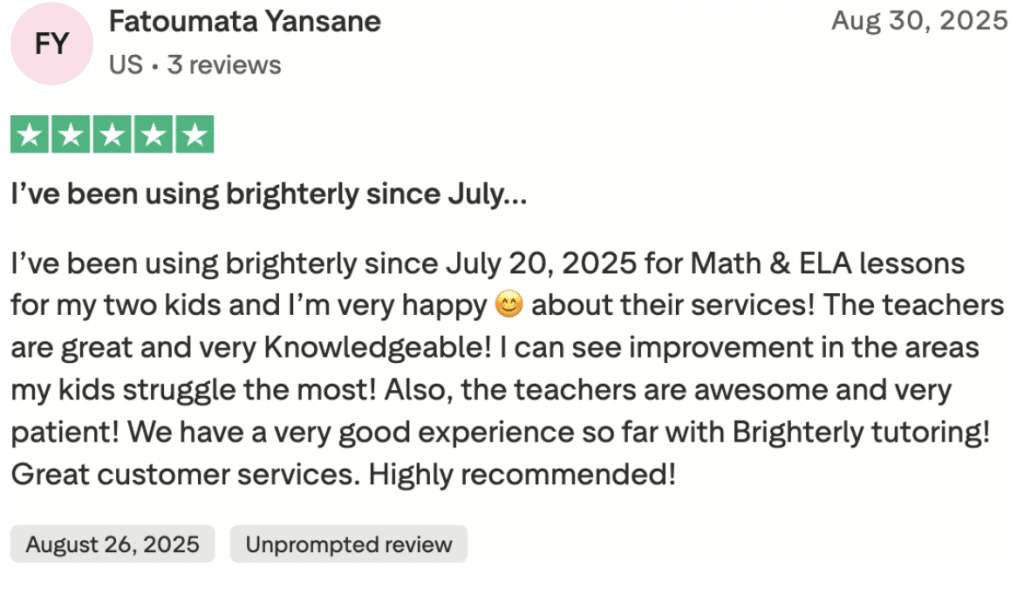
Kumon reviews from parents
Kumon has a slightly lower overall rating on Trustpilot — 4.0, which is still good. Kumon’s ratings are predominantly positive, with negative reviews here and there that mention this: Kumon has no real impact on the kids’ performance.
Here’s an example of such a Trustpilot review.
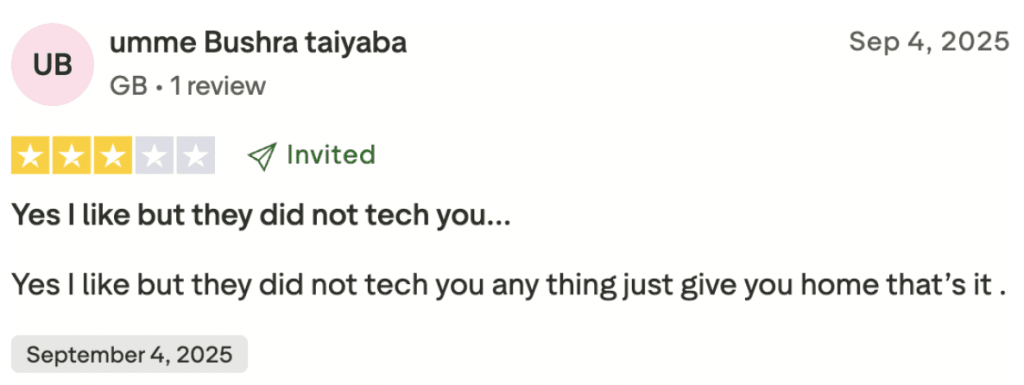
Others praise Kumon on Trustpilot for helping children build their skills through everyday practice:
“Kumon method helps develop the routine for everyday learning from very early in life; once everyday learning is vital to achieve goals.”
Abacus reviews
Abacus reviews are hard to come by, suggesting the platform isn’t very popular in 2025. But I was able to find some reviews on Reddit.
Reviewers predominantly mention that even though Abacus is good for improving basic addition, subtraction, division, and multiplication, it doesn’t deliver the same kind of improvement for more advanced math.

What’s the main difference between Kumon, Abacus, and Brighterly?
The main difference between Kumon, Abacus, and Brighterly is in their learning approach. Kumon focuses on bite-sized daily worksheets in math and reading; Abacus develops mental math through hands-on calculation techniques. Brighterly offers adaptive 1:1 online learning in math and reading, while aligning with school curricula.
Kumon or Abacus or Brighterly: Conclusion
To sum up, choosing a perfect platform means aligning the child’s needs, learning style, and your family’s priorities with what the platform offers.
- If you’re looking for structure, discipline, and consistent solo training with repeated tasks, Kumon is a good option.
- If your child is more visual/tactile, and you’re looking for hands-on learning and mental arithmetic, Abacus can be an effective choice.
- If your child needs adaptive guidance, gets bored with drills, or you are looking for something more engaging and aligned with what’s going on in school, Brighterly will be an excellent choice.
So, if you want your kid to finally say “I’ve got it — math is easy!”, book free lesson and help your kids thrive!
Other platforms comparison
Want more useful platform comparisons? Check out the experts’ articles below.

